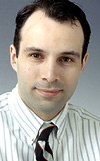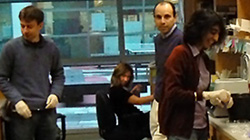
Breast oncologist Mark Moasser
UCSF researchers have discovered why drugs designed to target about one out of every four cases of breast cancer often fail to save women's lives or to stop these tumors from growing.
Due to genetic abnormalities, the breast cancers targeted by these drugs make unusually large amounts of a protein called HER2. HER2 relays signals within the cancer cells that drive tumor growth. Drugs are designed to inhibit the functioning of HER2 and prevent it from relaying these signals.
But for most women with HER2-driven tumors, these treatments do not work, or they keep the disease in check for only a limited time. Until now, researchers and clinicians have been mystified as to why treatments aimed at this promising target often fail to stop breast cancer growth.
UCSF breast oncologist and lab scientist Mark Moasser, MD, and his colleagues now say they have identified a compensatory biochemical response that enables HER2-driven tumor cells to survive all but complete inhibition of HER2. The researchers reported their findings in the January 25 issue of the scientific journal
Nature.
"It is much more difficult to stop tumor growth signals from HER2 than was previously thought," Moasser says. "But the discovery of the explanation for why this is so also points the way to much more effective therapies for HER-driven breast cancers. The road to the complete cure of this disease is now clearer than ever before."
Tripping Up a Molecular Relay Team
Through experiments carried out in large part by postdoctoral fellow Natalia Sergina, PhD, the researchers determined that despite inhibitory drug treatment, cancer cells adapt, so that HER2 can still transmit signals to HER3, a related protein with which it pairs off. Among the signals relayed down the track by HER2, some of the most important for cancer cell growth and survival must be passed on by HER3.
Two of the most important of these downstream proteins are PI3 kinase and Akt, which are targeted by drugs now being developed.

Moasser with postdoctoral fellows from his lab group -- Natalia Sergina, seated in back, Danislav Spassov, in blue sweater, and Deepika Ahuja.
Determining whether breast cancers overproduce HER2 is a routine part of the tumor classification used to help make treatment decisions. The effectiveness of drugs that target HER2 usually is gauged by looking at the activity of HER2 itself. That's the wrong approach, Moasser and colleagues have found.
New drug candidates that target HER2 should be tested to make sure they fully inhibit side-by-side signaling of HER2 to its partner HER3, Moasser says, "to ensure that all the cancer-promoting signals of HER2 have been inactivated."
When the UCSF researchers fully inactivated HER2 and HER3 signaling - using a laboratory technique called RNA interference - they found that HER2-driven breast cancer cells quickly died.
"This provides great hope that if we can do the same thing using drugs, we will be able to fully and effectively kill all such cancer cells in affected patients," Moasser says.
Moasser says resistance to current treatments for HER2-driven breast cancer might be overcome in part by combining current HER2 inhibitors with other targeted drugs that separately attack either HER3 or downstream proteins.
For the work reported in
Nature, Moasser's lab team collaborated with UCSF molecular pharmacologist Kevan Shokat, PhD, and members of his laboratory.
Escape from HER-family tyrosine kinase inhibitor therapy by the kinase-inactive HER3
Natalia V. Sergina, Megan Rausch, Donghui Wang, Jimmy Blair, Byron Hann, Kevan M. Shokat and Mark M. Moasser
Nature 445:437-441, 25 January 2007)
Abstract |
Full Text | Full
Text (PDF) |
Related Links:
Research Highlight: Anticancer Drugs: Escaping Inhibition
Nature Reviews Drug Discovery 6:111, February 2007
Mark M. Moasser, MD
UCSF Comprehensive Cancer Center
UCSF Comprehensive Cancer Center
Shokat Laboratory

